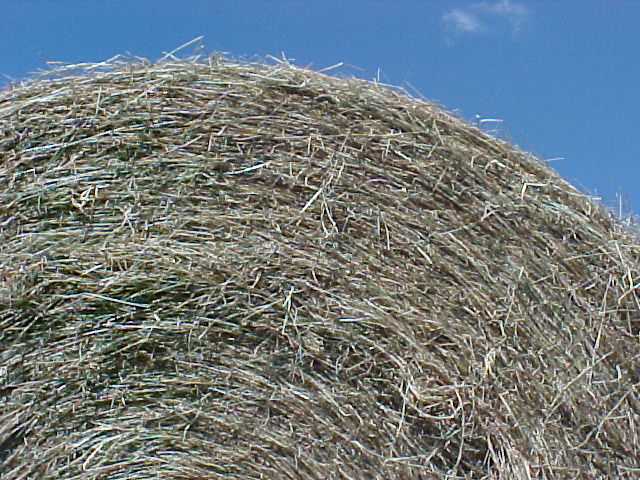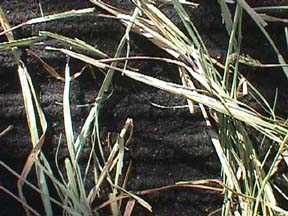|
Top quality hay: production
and protection |
|

Prime bail
The
reality is there are more hay consumers than hay producers. We sell most
of our hay WELL in advance of the feeding season. If you are going to
need hay, you need to plan ahead. If you get in a bind, call and we'll
see if we can help you out or put you in touch with someone who can.
Laney Farms has a long
tradition of producing the finest quality hay for horses and cattle. We
have become known in our area for providing a reliable supply of hay for
people with both large and small needs.
|
Types of
Grasses
 At
Laney Farms, we know that to get any good finished product you must start with
quality ingredients. We don't bail junk!! For our finest quality horse
hays we begin with Russell Bermuda grass fields. Yes, it's that stuff you've
been trying to get out of your flower bed since the beginning of time. Bermuda
is a thin blade to flexible stalk, light green to gray/green in color. It is
considered one of the higher fiber hays. The Russell variety is an Alabama
discovery that was released officially in 1995. Russell exhibits most of the
desirable traits needed in a hybrid type, including top yield potential and
rapid ground covering ability. We also use other fields which are majority
Coastal Bermuda grass. All of the fields we cut are treated regularly to block
the growth of noxious weeds.
At
Laney Farms, we know that to get any good finished product you must start with
quality ingredients. We don't bail junk!! For our finest quality horse
hays we begin with Russell Bermuda grass fields. Yes, it's that stuff you've
been trying to get out of your flower bed since the beginning of time. Bermuda
is a thin blade to flexible stalk, light green to gray/green in color. It is
considered one of the higher fiber hays. The Russell variety is an Alabama
discovery that was released officially in 1995. Russell exhibits most of the
desirable traits needed in a hybrid type, including top yield potential and
rapid ground covering ability. We also use other fields which are majority
Coastal Bermuda grass. All of the fields we cut are treated regularly to block
the growth of noxious weeds.
Cutting,
Curing, and Bailing
The simple fact is, if we cut
the field too early we lose money, and if we cut the field too late we lose
money. The balance of producing a grass that is soft and desirable to the
animals and producing the most grass as possible is a fine point. Bermuda grass
is the softest when young and short, but the grass has not sufficiently absorbed
the fertilizers and other nutrients from the ground that are needed for your
animals health. A grass that is too long tends to get "stemmy" and very straw
like. As a rule of thumb a field is not put on the cutting schedule until the
grass is just below the knee (about 20"), then it must be cut before it begins
to "lay down" (about 25"). Between those points we begin to watch the weather
forecasts. We need either 2 HOT dry days or 3 moderate days without rain to
complete the harvesting. As I've told my wife, "hay is not ruined when it gets
wet after being cut, but it's kind of like pouring milk on your frosted flakes
and then pouring it off and letting the cereal dry out again." Each time the cut
grass gets wet a portion of the total nutritional value is lost, so timing of
weather patterns is crucial. We begin the bailing process only after the
moisture percentage is between 15-20% for round bales and between 10-15% for
square bales. The finished bale weights in at ~1,100lbs round and 55lbs square.

 At
Laney Farms, we know that to get any good finished product you must start with
quality ingredients. We don't bail junk!! For our finest quality horse
hays we begin with Russell Bermuda grass fields. Yes, it's that stuff you've
been trying to get out of your flower bed since the beginning of time. Bermuda
is a thin blade to flexible stalk, light green to gray/green in color. It is
considered one of the higher fiber hays. The Russell variety is an Alabama
discovery that was released officially in 1995. Russell exhibits most of the
desirable traits needed in a hybrid type, including top yield potential and
rapid ground covering ability. We also use other fields which are majority
Coastal Bermuda grass. All of the fields we cut are treated regularly to block
the growth of noxious weeds.
At
Laney Farms, we know that to get any good finished product you must start with
quality ingredients. We don't bail junk!! For our finest quality horse
hays we begin with Russell Bermuda grass fields. Yes, it's that stuff you've
been trying to get out of your flower bed since the beginning of time. Bermuda
is a thin blade to flexible stalk, light green to gray/green in color. It is
considered one of the higher fiber hays. The Russell variety is an Alabama
discovery that was released officially in 1995. Russell exhibits most of the
desirable traits needed in a hybrid type, including top yield potential and
rapid ground covering ability. We also use other fields which are majority
Coastal Bermuda grass. All of the fields we cut are treated regularly to block
the growth of noxious weeds.